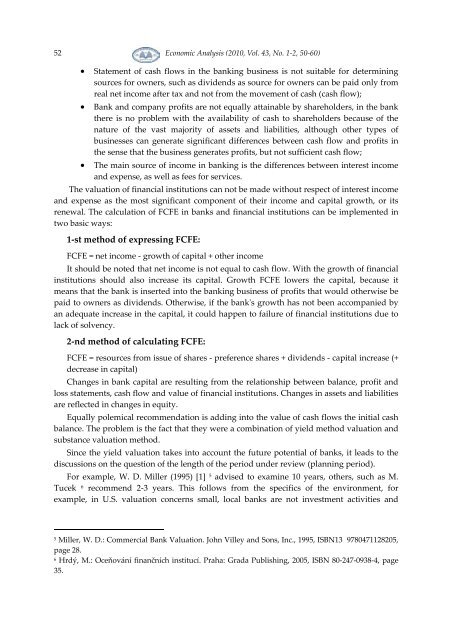Twice a Year Scientific Journal
Twice a Year Scientific Journal
Twice a Year Scientific Journal
You also want an ePaper? Increase the reach of your titles
YUMPU automatically turns print PDFs into web optimized ePapers that Google loves.
52<br />
Economic Analysis (2010, Vol. 43, No. 1-2, 50-60)<br />
• Statement of cash flows in the banking business is not suitable for determining<br />
sources for owners, such as dividends as source for owners can be paid only from<br />
real net income after tax and not from the movement of cash (cash flow);<br />
• Bank and company profits are not equally attainable by shareholders, in the bank<br />
there is no problem with the availability of cash to shareholders because of the<br />
nature of the vast majority of assets and liabilities, although other types of<br />
businesses can generate significant differences between cash flow and profits in<br />
the sense that the business generates profits, but not sufficient cash flow;<br />
• The main source of income in banking is the differences between interest income<br />
and expense, as well as fees for services.<br />
The valuation of financial institutions can not be made without respect of interest income<br />
and expense as the most significant component of their income and capital growth, or its<br />
renewal. The calculation of FCFE in banks and financial institutions can be implemented in<br />
two basic ways:<br />
1-st method of expressing FCFE:<br />
FCFE = net income - growth of capital + other income<br />
It should be noted that net income is not equal to cash flow. With the growth of financial<br />
institutions should also increase its capital. Growth FCFE lowers the capital, because it<br />
means that the bank is inserted into the banking business of profits that would otherwise be<br />
paid to owners as dividends. Otherwise, if the bankʹs growth has not been accompanied by<br />
an adequate increase in the capital, it could happen to failure of financial institutions due to<br />
lack of solvency.<br />
2-nd method of calculating FCFE:<br />
FCFE = resources from issue of shares - preference shares + dividends - capital increase (+<br />
decrease in capital)<br />
Changes in bank capital are resulting from the relationship between balance, profit and<br />
loss statements, cash flow and value of financial institutions. Changes in assets and liabilities<br />
are reflected in changes in equity.<br />
Equally polemical recommendation is adding into the value of cash flows the initial cash<br />
balance. The problem is the fact that they were a combination of yield method valuation and<br />
substance valuation method.<br />
Since the yield valuation takes into account the future potential of banks, it leads to the<br />
discussions on the question of the length of the period under review (planning period).<br />
For example, W. D. Miller (1995) [1] 5 advised to examine 10 years, others, such as M.<br />
Tucek 6 recommend 2-3 years. This follows from the specifics of the environment, for<br />
example, in U.S. valuation concerns small, local banks are not investment activities and<br />
5<br />
Miller, W. D.: Commercial Bank Valuation. John Villey and Sons, Inc., 1995, ISBN13 9780471128205,<br />
page 28.<br />
6<br />
Hrdý, M.: Oceňování finančních institucí. Praha: Grada Publishing, 2005, ISBN 80-247-0938-4, page<br />
35.
















